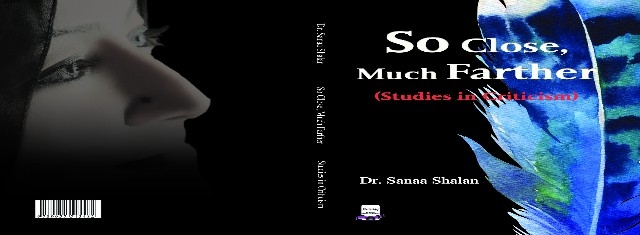News
Publishing “So Close, Much Farther“
Sanaa Shalan

“So Close, Much Farther“ for Sanaa Shalan
USPA NEWS -
Jordan/Amman:
Issued by Amwaj House for Publishing and Distribution Issued by the author Dr. Sanaa Shalan, is a book in the English language entitled: (So Close, Much Farther: Studies in Criticism).
It is 143 pages long and contains three chapters, the first with a title: (Sexual motivation as a tool to incriminate women in the story of: The Scheming of Women and Their Snare is Mighty, in A Thousand and One Nights.)
Issued by Amwaj House for Publishing and Distribution Issued by the author Dr. Sanaa Shalan, is a book in the English language entitled: (So Close, Much Farther: Studies in Criticism).
It is 143 pages long and contains three chapters, the first with a title: (Sexual motivation as a tool to incriminate women in the story of: The Scheming of Women and Their Snare is Mighty, in A Thousand and One Nights.)
This chapter raises the hypothesis that the sexual motivation was a tool to incriminate women as in the story of “Thousand and One Night“ or the “Tales of Fablio“ trying to highlight the social and cultural aspects of the details in these stories. The female body, in these stories, is robbed of its natural right of sending discreet signals and is confined solely to sending signals of lust. This hypothesis is portrayed in the story of: “Slyness of Women and Their Cunning Is Mighty“ which includes a collection of internally multiplying stories created inside that story during the nights extending from night (574) till night (608). We chose the following stories from the “Tales of Fablio“ for study: “The Woman Who Convinced Her Husband That He Was Dreaming“, “Aristotle´s Poem“, “Mr. Hano and Mrs. Anios“ and “The Two Partridges“.
While the second chapter in the book is titled: (Fantasy worlds in the novel of: (Ahramian) by Jordanian novelist Ghassan El Ali).
While the second chapter in the book is titled: (Fantasy worlds in the novel of: (Ahramian) by Jordanian novelist Ghassan El Ali).
The Jordanian novelist Ghassan El Ali presents in his novel (Ahramian) a fantasy world which innovates a new experiment with high sensitivity which reflects a special awareness towards things whether in form or content. This awareness is based on the techniques of breaking the narrative sequence beyond the traditional plot. It dives into the inner part and clutches to the appearance expanding the significance of the reality, so the dream, the myth and poetry return to it. It puts the miraculous and the extraordinary in the place of granted reality without astonishment. It provides openness to the worlds and universes of the subconscious, but time has been broken and marginalized within rare harmony.
Chapter Three of this book is entitled: (Experimentation in the Jordanian Novel: Fantasy Narrative as a Path.)
This study addresses the experimentation in the contemporary Jordanian novel. It assumes that there is a movement of experimentation and innovation in these novels in the way of form and content. It chooses this trend towards fantasy as a remarkable path in the experimentation movement in the Jordanian novel. This trend has its wide presence which is characterized by its styles and characteristics. It has also its employment justification, it has used specific language and certain narrative appropriate for this trend which dominated even the classical and factual novel and pierced its system.
This study addresses the experimentation in the contemporary Jordanian novel. It assumes that there is a movement of experimentation and innovation in these novels in the way of form and content. It chooses this trend towards fantasy as a remarkable path in the experimentation movement in the Jordanian novel. This trend has its wide presence which is characterized by its styles and characteristics. It has also its employment justification, it has used specific language and certain narrative appropriate for this trend which dominated even the classical and factual novel and pierced its system.
Liability for this article lies with the author, who also holds the copyright. Editorial content from USPA may be quoted on other websites as long as the quote comprises no more than 5% of the entire text, is marked as such and the source is named (via hyperlink).





